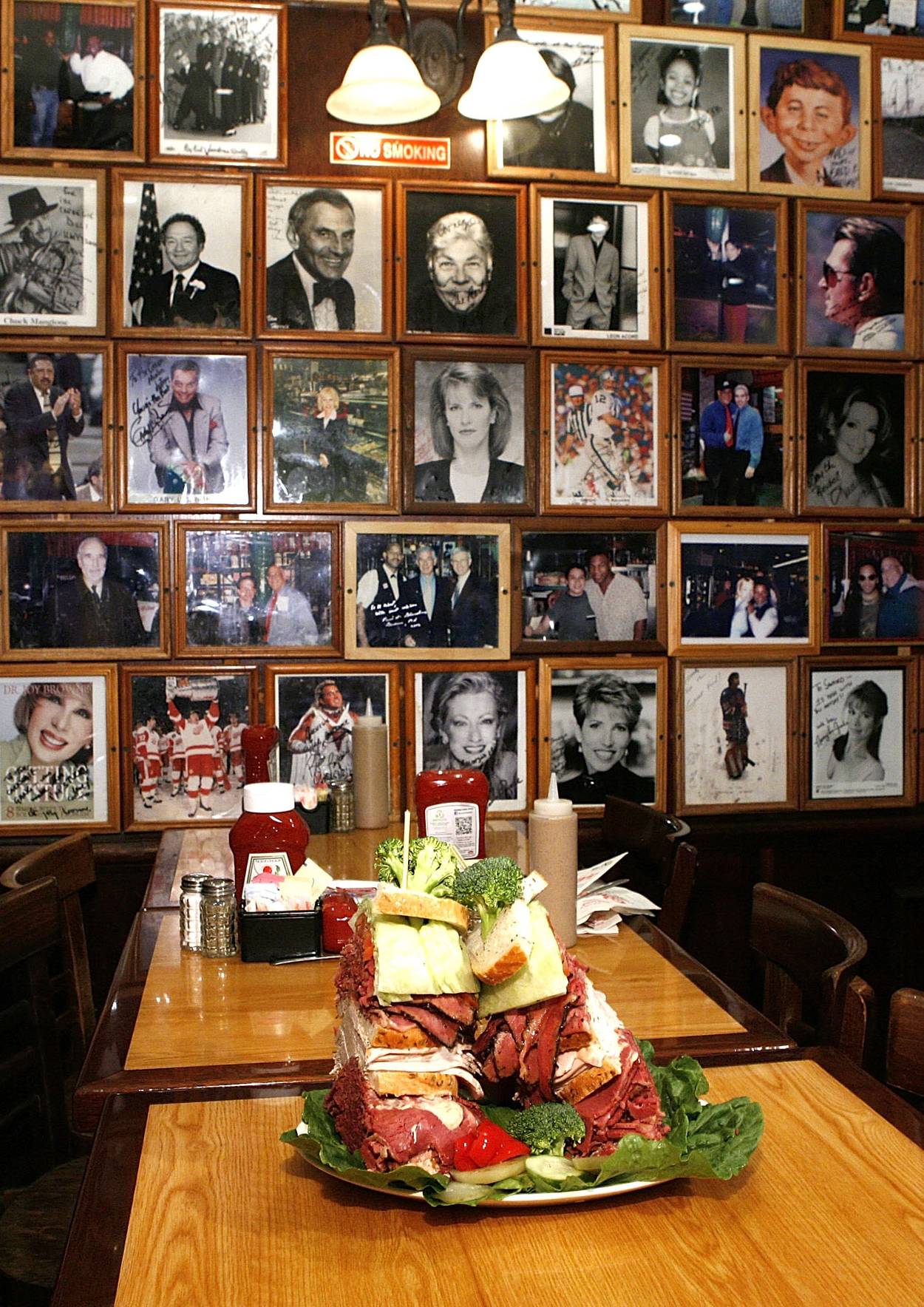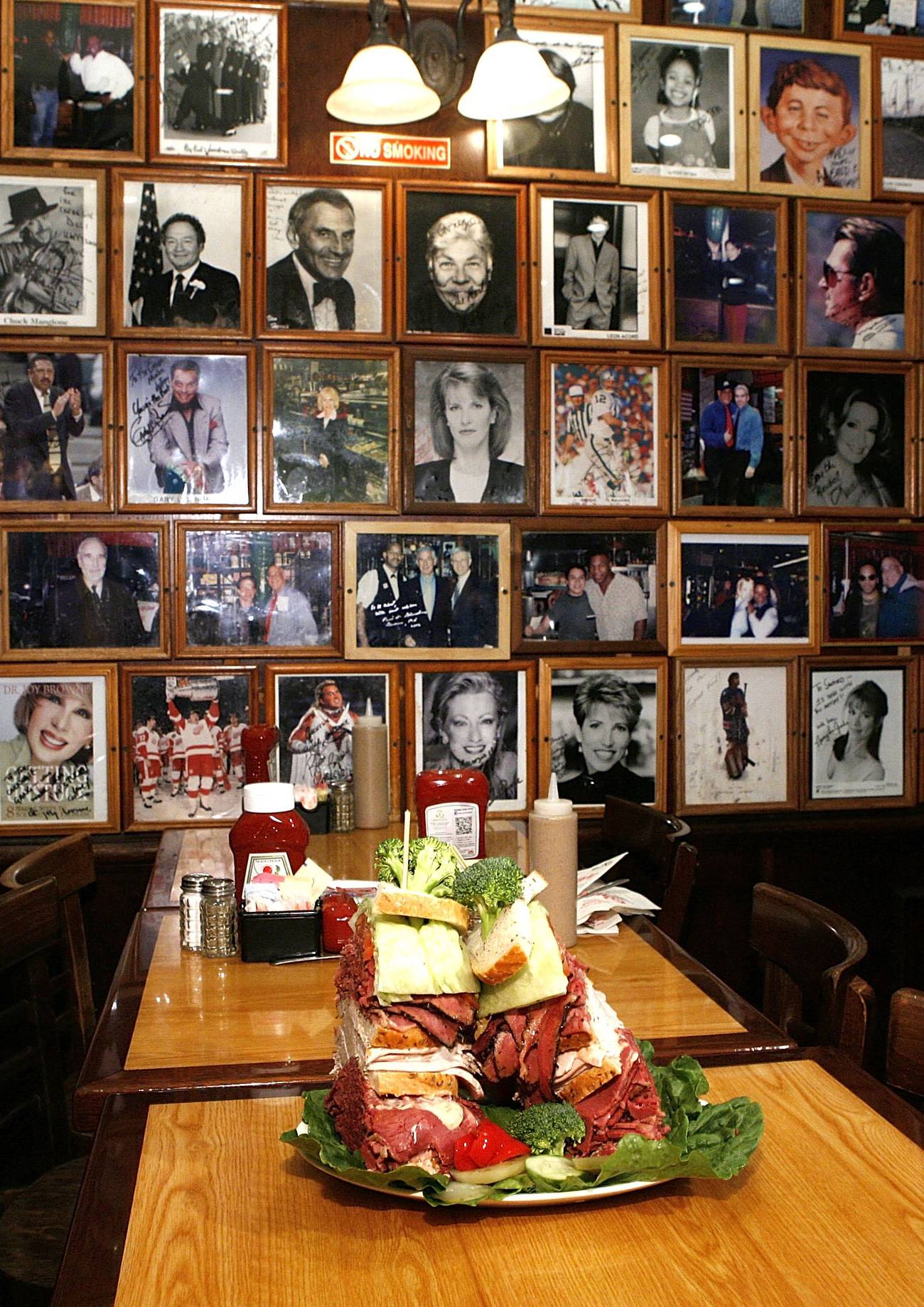The Deli Celebrity
How delicatessens became associated with stars—on the walls, at the tables, and on the menus




It has probably been a while since you set foot in a Jewish delicatessen (or any restaurant, for that matter). But close your eyes, and you can see it: the Formica counters and the line of brick-red sausages suspended above it, the white ceramic plates holding sandwiches piled sky high with glistening meat, the aluminum serving bowls swimming with half-sours.
Then, of course, there are the photos lining the walls: row after row of autographed headshots and posed snaps of anyone D-list or higher, standing with their arms draped chummily over the deli owner’s shoulder. On the table, the menu sprawls open to reveal an endless list of sandwiches—different combinations of pastrami, turkey, corned beef, tongue, and brisket named after the very same celebrities mugging on the wall.
The celebrity presence at the classic Jewish deli is so commonplace, it hardly feels noteworthy. Like the pleather booths or world-weary servers, they are simply part of the gestalt. But stepping back, it’s rather remarkable. Delicatessens are undeniably delightful, but they are hardly the Four Seasons. How did the creme de la creme of American stardom—the gatekeepers of glitz and glamour—end up slumming like schlubs at the deli?
As it turns out, proximity had a lot to do with it. “The original connection is that the deli served the immigrant Jewish community, including the Yiddish theater actors on the Lower East Side,” said David Sax, author of Save the Deli: In Search of Perfect Pastrami, Crusty Rye, and the Heart of the Jewish Delicatessen. “Business happened at the deli—people reviewed contracts, read scripts—it was a central part of that world.” More than a few disappointed actors’ egos were likely soothed by the balm of hot pastrami. And, as the tender Stage Deli scene from The Marvelous Mrs. Maisel demonstrates, an equal number of celebratory moments were shared over a plate of pickles.
After WWI, the show business industry skyrocketed and the locus of theater, live music, and the silent film industry blossomed further north in Manhattan. “Jews were active as playwrights, theater owners, songwriters, and performers,” said Ted Merwin, author of Pastrami on Rye: An Overstuffed History of the Jewish Deli. “At that time, showbiz was second only to the garment industry as a Jewish business.”
Delicatessens like Reuben’s and Lindy’s were there to feed the scene—including Jewish performers who had made it to the big time, but longed for simpler, more familiar comforts. In his autobiography, Harpo Speaks, the Jewish comedian and mime Harpo Marx wrote that at Lindy’s, “I was back with my own people, who spoke my language, with my accent—cardplayers, horseplayers, bookies, song-pluggers, agents, actors out of work, and actors playing the Palace ... The cheesecake was ambrosia. The talk was old, familiar music ... Home Sweet Home.”
Jewish delis also became the de facto spot for the after party. Starlets, crooners, and leading men would hold court at their booths, while comedians worked out their tight 10 for anyone seated nearby. The Jewish entertainer Al Jolson (who is best known as the star of the 1927 film The Jazz Singer) was famous for inviting his live audiences back to Lindy’s for a pastrami sandwich after the theater managers turned the lights on and began mopping the aisles. What a thrill it must have been for Jewish theatergoers in particular to rub shoulders with their favorite stars. “These moments at the deli offered a fantasy of what the future could be,” Merwin said. “The 1920s was an incredibly anti-Semitic time period. And yet, in the deli, they could feel vicariously like real Americans.”
Before long, the symbiotic relationship between delicatessens and the hardest working guys and gals in showbiz was solidified. The framed headshots and caricatures of stars’ profiles began to go up on delicatessen walls. Famed celebrity caricaturist Al Hirschfeld’s drawings—of Mae West, Eddie Cantor, and other luminaries—graced the cover of The Stage Deli’s menu. At Canter’s Deli in Los Angeles, Nancy Sinatra dedicated a booth to radio personality Rodney Bingenheimer, who is a Canter’s regular and the unofficial “Mayor of Sunset Strip.”
The tradition of naming sandwiches after stars began in 1937, when the Stage Deli’s owner, a Russian Jewish immigrant named Max Asnas, invited famous diners up to the meat carving board to construct their own wild combinations. By the 1990s, everyone from Joe DiMaggio (corned beef, pastrami, chopped liver, and Bermuda onion) to Oprah Winfrey (corned beef, sliced turkey, pastrami, roast beef, Swiss, and Russian dressing) had received the sandwich treatment. Dolly Parton’s eponymous Stage Deli sandwich was, cheekily, composed of twin rolls stuffed with pastrami and corned beef.
Jewish delicatessens were not the only restaurants to showcase their connections to the stars. Midcentury Italian red sauce joints and steakhouses in New York and beyond were also known to adorn their walls with photos or caricatures of famous clientele. But it is safe to say that the deli-celebrity connection was the most consistent and robust. Merwin said these restaurants’ collective obsession with movie and theater stars (and later political figures and sports heroes) came down to insecurity. For the first- and second-generation Jewish immigrants who operated and patronized the delicatessen, he said, “there was this feeling of not being important in society, and wanting to be. There was a need to prove that we could hobnob with the rich and famous.”
Over time, that need has faded. The Jewish community is firmly settled into its American-ness, and dishes like pastrami and bagels have transitioned from niche cuisine to the mainstream. As a result, today’s delicatessens no longer need to rub shoulders with celebrities to solidify their worth. “In LA, you still have industry people meeting for lunch at Canter’s, at least prior to COVID,” Sax said. But today, you are more likely to find Hollywood stars sipping chaga mushroom lattes or brunching at Gjelina than slurping matzo ball soup at Factor’s, as delicious as it is. And at the “next gen” delicatessens—artisanally minded places that opened in the mid-aughts or later—the walls typically are lined with gleaming subway tile rather than celeb photos.
Nouveau delicatessens have continued the tradition of creative sandwich names. But instead of celebrities, they tend to opt for tongue-in-cheek Jewish puns. At Portland’s Kenny & Zuke’s, for example, a sandwich loaded with pastrami, corned beef, turkey, and salami is called “The Meshugaletta,” a portmanteau of the Yiddish word for crazy and New Orleans’ meat-heavy muffaletta sandwich. And Perly’s in Richmond, Virginia, has the “Tuna Schmelt” (dill-flecked tuna salad and swiss on a bagel), “Schlubby Fries” (french fries topped with cheese, pastrami, and Russian dressing), and several other kitschily named dishes.
The exceptions only help to prove the rule. Brooklyn’s Mile End Deli serves a whitefish salad sandwich called the Larry David, after the Curb Your Enthusiasm star. But as far as owner Joel Tietolman knows, David has never visited Mile End. (“Jessica Seinfeld picked up matzo ball soup from us, though, so there’s a second degree of connection,” he said with a laugh.) Instead, the name references an episode where David attempts to switch signature sandwiches with Ted Danson, who was given what David believes is a superior sandwich by their local delicatessen. By naming their whitefish sandwich after that episode, Mile End simultaneously nodded to the tradition of celebrity sandwiches, while turning it on its head.
While the deli-celebrity relationship has faded, it has also found new expressions. Take the 2012 episode of Louie, where Louis C.K. and Parker Posey’s characters go on an indulgent spree of a date at Russ & Daughters. The scene culminates with C.K., head tipped back and eyes wild with revelry, eating raw, new-catch herring. The episode likely drew some new customers to Russ & Daughters, but the iconic, century-old Jewish appetizing shop hardly needed the boost. Instead, the scene helped Louie flex old school, New York City street cred.
Meanwhile in March 2020, the band Haim (fronted by Jewish sisters Este, Danielle, and Alana Haim) launched a “delicatessen tour” in homage to their first-ever show (as teenagers) at Canter’s Deli. The tour was cut short by COVID-19 shutdowns, but not before they played at Sarge’s Deli in Manhattan and Call Your Mother in Washington, D.C. Haim’s music is not explicitly Jewish, but playing a set with whitefish salad and potato latkes perfuming the air let them play with their hearts on their sleeves.
In the age of social media, the virtual “walls” of the delicatessen are lined with rippled slices of chocolate babka, fatty stacks of pastrami, and matzo balls ready for their close up. Customers come for food, more than to star gawk. Is it a good day if Seth Rogen stops by for a bagel and schmear? Sure, it is. But with or without the celebrities, the Jewish deli has become the star.